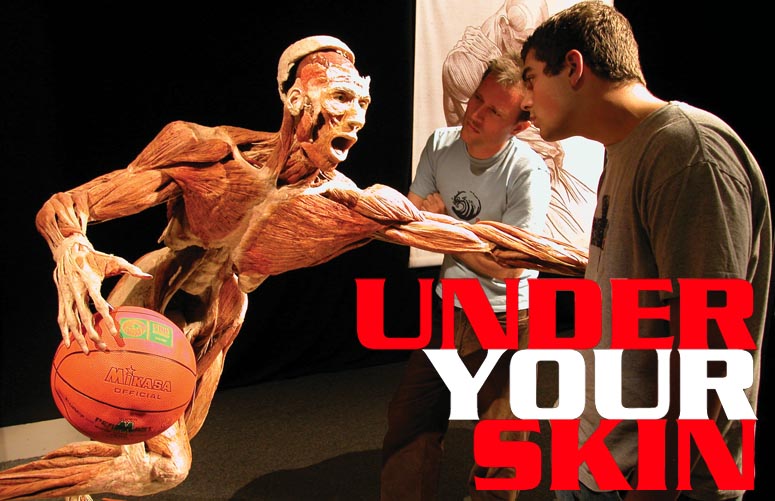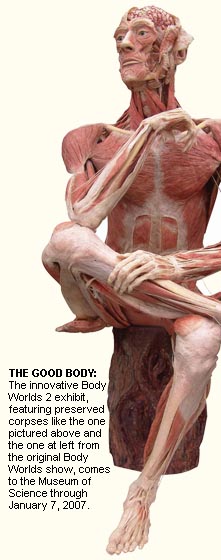

A skinless man sits with his legs crossed, looking as though he’s contemplating the mysteries of the universe through unblinking eyes. Another human body hangs suspended in mid-air, like a fly trapped in amber, as its foot prepares to kick a soccer ball, its every exposed muscle tensed for impact.
It sounds bizarre, perhaps a little frightening, but undeniably fascinating. And that’s the hook of the Museum of Science’s much-talked about new exhibit Body Worlds 2, which gives the average person a glimpse into the inner workings of the human body that few people outside a medical lab have ever seen. The exhibit, which runs through January 7, 2007, displays real, preserved human bodies, organs and tissues as a way of helping us understand what’s really on the inside of those bodies we spend so much time trying to perfect on the outside.
“The fact that this exhibit uses real human specimens gives people an unprecedented opportunity to see human anatomy up close,” says Paul Fontaine, VP of Programs at the Museum of Science. “A very small percentage of people—medical students, mostly—have really had that once-in-a-lifetime opportunity to see this.”
The 200 remarkable specimens in Body Worlds 2 are preserved through a process called Plastination, developed in 1977 by German anatomist Gunther von Hagens. Plastination involves extracting all bodily fluids and fats from a particular organ (or, in the case of the 24 full-body “plastinates” in Body Worlds 2, an entire human corpse) and replacing them with resins and elastomers—essentially, plastics—that are forced into the tissue by vacuum pressure. The body is then molded into a passive or action “pose,” and then cured with light, heat or certain gases until it is rigid. The end result: a real human “sculpture,” as it were.
 Von
Hagens initially envisioned the Plastination
process as an alternative to the somewhat
limiting and artificial models/specimens
used by anatomists and medical students in
laboratory settings. As the Plastination
process developed and advanced, however, it
became clear to him that these eerily
lifelike specimens could have a life outside
the lab.
Von
Hagens initially envisioned the Plastination
process as an alternative to the somewhat
limiting and artificial models/specimens
used by anatomists and medical students in
laboratory settings. As the Plastination
process developed and advanced, however, it
became clear to him that these eerily
lifelike specimens could have a life outside
the lab.
“He’s really got this passion,” says Fontaine, “for sharing the wonders of the human body with as many people as possible.” The Plastination process preserves the conditions that these real human bodies were in at their times of death, allowing visitors to not only see how the inner workings of a typical healthy body look, but also the physical effect that things like smoking tobacco or various diseases have on body tissue. Viewers can also see how artificial supports such as knee and hip replacements are seemlessly integrated into human musculature and bones.
Fontaine says that Museum of Science administrators were profoundly aware of the extreme reactions viewers might have to such an unusual, graphic—some might even say macabre—exhibition. “Our initial concerns centered on the ethics of the exhibition itself,” says Fontaine. “It was vitally important that the specimens in Body Worlds were the result of donations for this particular purpose.”
After satisfying themselves, museum administrators consulted with respected members of the medical community, as well as area religious leaders and elected officials to ensure that bringing Body Worlds 2 to Boston was something residents would respond favorably to. “It led to really good talks—it’s been educational for us to hear back from the citizenry about the issues and sensitivities that could be raised by the show,” says Fontaine.
Fontaine says that what Body Worlds 2 has most impressed upon him is the astounding capabilities of the human body as a whole. “It’s amazing how many complex systems are stuffed into such a small package,” he marvels. “I mean, the digestive system is 50 feet long… the nervous system is actually miles long. And it’s all contained in a human form 5 to 6 feet tall. Body Worlds 2 really shows that the human form is a miracle of evolution.”
As the museum embarks on what Fontaine calls a concentrated “life sciences initiative,” which will eventually include a yet-to-be-established Hall of Human Anatomy, the hope is that Body Worlds 2 will whet a public appetite for understanding the mysteries to be found deep within ourselves.
“We’re hoping this exhibit will encourage
visitors to let us know about their
particular interests in human health,
anatomy, lifestyle choices and more,” says
Fontaine. “I think we take our bodies for
granted. Hopefully [Body Worlds 2] will be
moving and inspirational, and I think it
will make us pay closer attention to how we
all choose to live. I don’t think anyone
will look at their body quite the same way
again.” Refer to
listing.

back to homepage